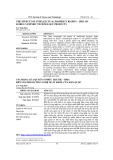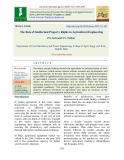
Int.J.Curr.Microbiol.App.Sci (2018) 7(11): 3151-3158
3151
Review Article https://doi.org/10.20546/ijcmas.2018.711.362
The Role of Intellectual Property Rights in Agricultural Engineering
P.S. Joshi and S.V. Pathak*
Department of Farm Machinery and Power Engineering, College of Agril. Engg. and Tech.,
Dapoli, India
*Corresponding author
A B S T R A C T
Introduction
In Indian agriculture, it has some unique
characteristics having 250 different crops
cultivated in different agro-climatic
conditions. In Indian economy, agriculture
sector play the crucial role, with 18.5 per cent
share in national income; 15 per cent of total
exports with two-thirds of work force engaged
in this sector. Inputs from agricultural
engineering have played dominant role in
boosting the productivity and production
through appropriate mechanization technique.
In India, agricultural equipment market was
valued at Rs. 299.1 billion in the year 2010
and it has tremendous capacity for further
growth and development.
Benefits of productivity from farm
mechanization and credit facility available in
farmers hand has developed the demand for
agricultural machinery.
In ancient time, throw back to sixties when
inventions of tractors and seed drills were
utilized as agriculture machinery.
After a decade, tractors, tractor drawn
cultivators, threshers and ploughs were came
into existence. Then main focus was on
tractors followed by seeders, ploughs and
sprayers. From 2000 onwards, the whole
inventions were shifted towards increasing
mechanization in the pre-harvest and post-
harvest agriculture machinery (Manchikanti
and Sengupta, 2011)
International Journal of Current Microbiology and Applied Sciences
ISSN: 2319-7706 Volume 7 Number 11 (2018)
Journal homepage: http://www.ijcmas.com
Nowadays, people looking towards the agriculture as industrial point of view
or as business, which cannot sustain without research and development and
astute investments. In the past three decades, the role of intellectual property
rights (IPRs) in agribusiness has increased enormously. Apart from investment
in agricultural research, intellectual property rights (IPRs) have profound
impact on technology development, and its transfer. There has been an
increasing interest in the innovations of pre-harvest as well as post-harvest
agriculture machinery. The present paper gives an idea about intellectual
property different inventions in agriculture also takes an overview of the
current scenario of geographical indications in India.
Keywords
IPRs, Agricultural
machinery, Agricultural
technology, Geographic
indications, Indian
agriculture
Accepted:
26 October 2018
Available Online:
10 November 2018
Article Info























